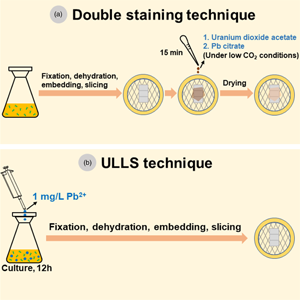Article contents
Transmission Electron Microscopy Analysis on Microbial Ultrathin Sections Prepared by the Ultra-Low Lead Staining Technique
Published online by Cambridge University Press: 23 July 2021
Abstract

The staining procedure is critical for investigating intra- and extra-cellular ultrastructure of microorganisms by transmission electron microscopy (TEM). Here, we propose a new ultra-low lead staining (ULLS) technique for preparing the ultrathin sections for TEM analysis. Sections of Enterobacter sp. (bacteria), Aspergillus niger (filamentous fungi), Rhodotorula mucilaginosa (fungi), and Chlamydomonas reinhardtii (microalgae) were tested. Compared with the sections prepared by the typical double-staining technique, ULLS-based sections showed evident advantages: (i) the staining process only required the addition of Pb(NO3)2; (ii) the Pb level during incubation was set as low as 1 mg/L, which had negligible toxicity to most microbial cells; (iii) the Pb cations were added during microbial culture, which avoided complicated sample preparation as in typical double staining. Taking C. reinhardtii as an example, the ULLS technique allowed fine investigation of microbial ultrastructure, e.g., starch granule, mitochondrion, Golgi apparatus, vacuole, and vesicle. Meanwhile, the physiological processes of the cells such as cell lysis and exocytosis were successfully captured, with relatively high contrast. This study hence shows a bright future on preparation of the high-quality ultrathin sections of microbial cells by the ULLS technique.
- Type
- Micrographia
- Information
- Copyright
- Copyright © The Author(s), 2021. Published by Cambridge University Press on behalf of the Microscopy Society of America
Footnotes
These authors contributed equally to this work.
References
- 4
- Cited by





